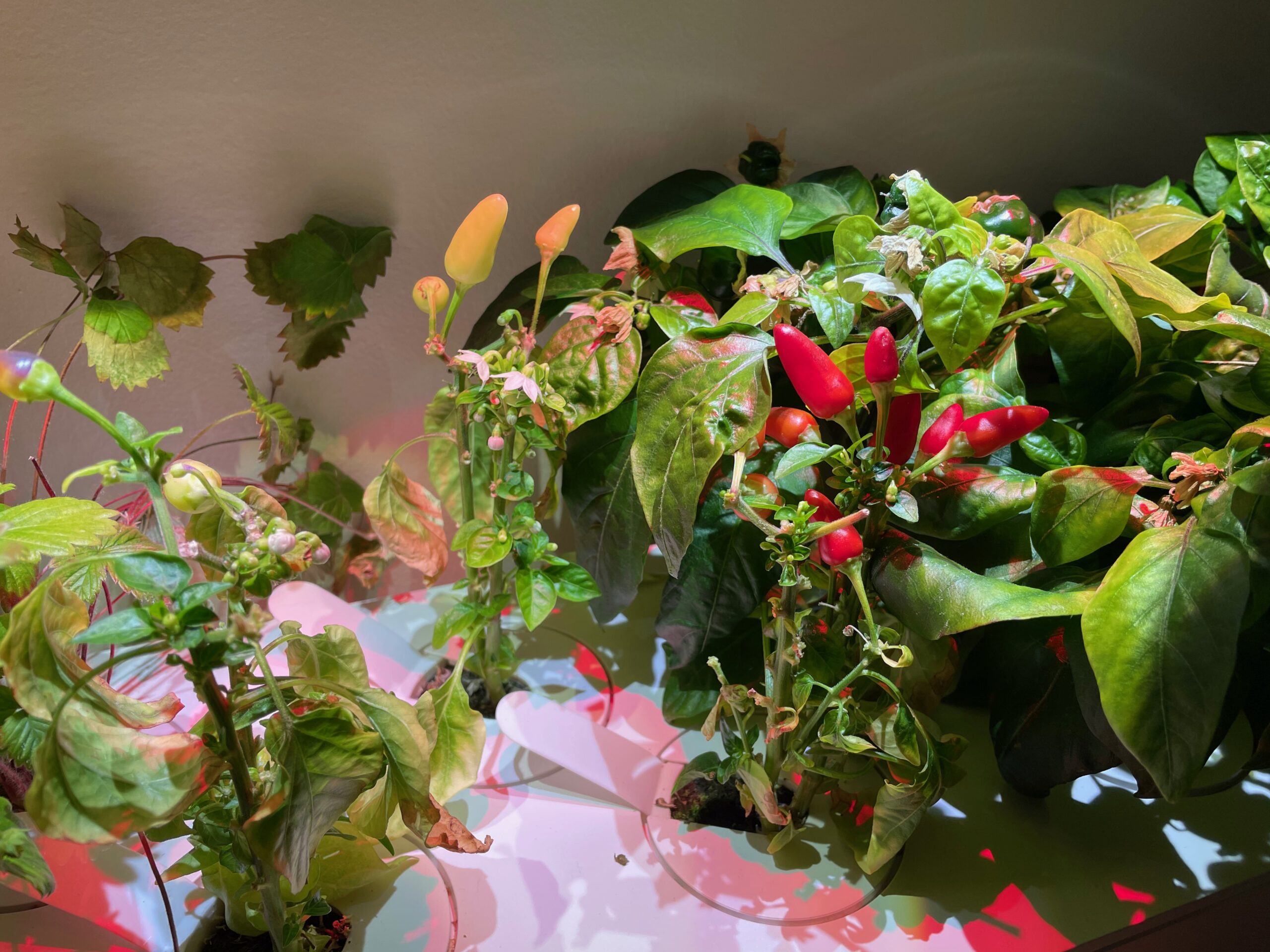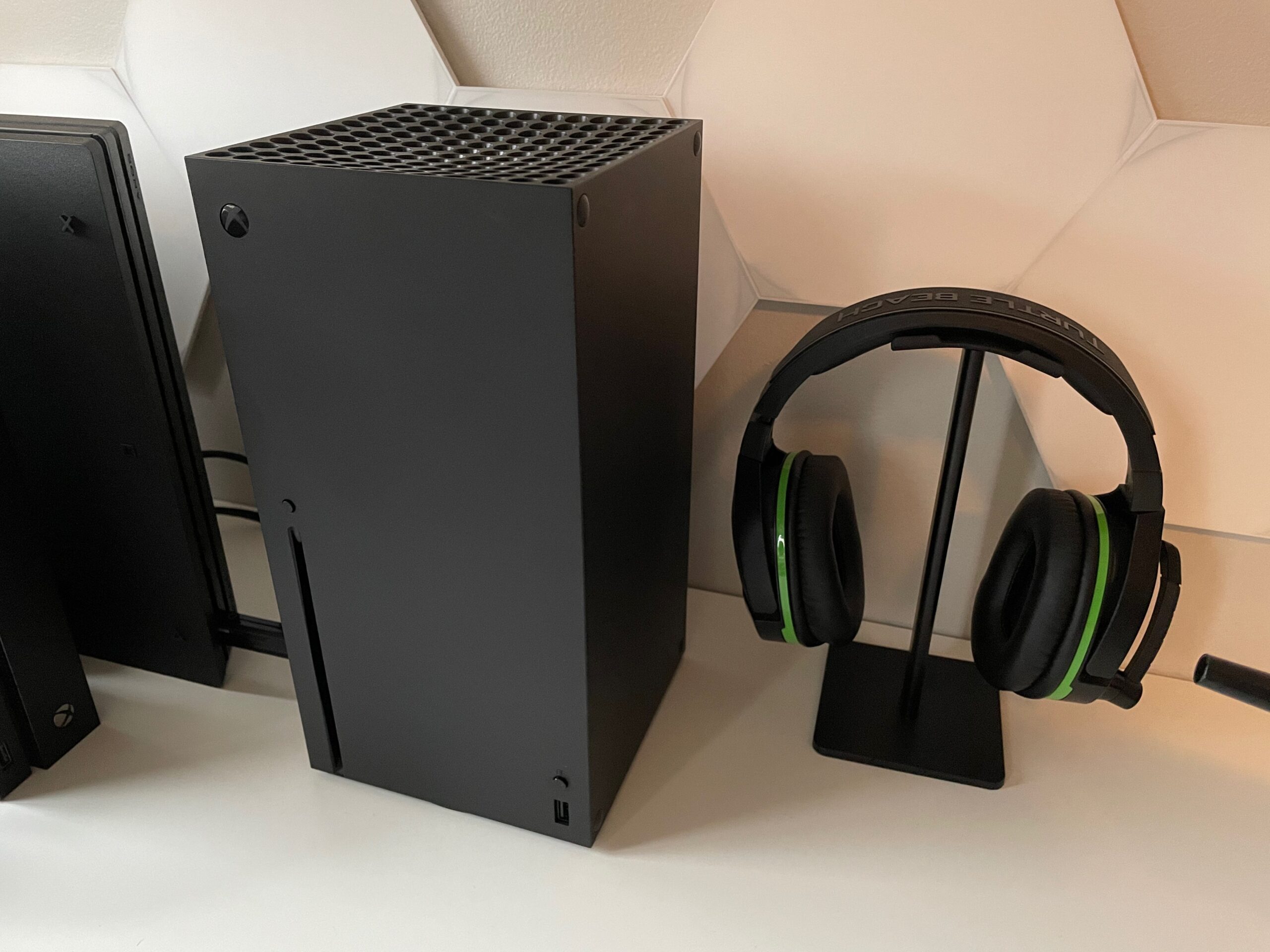
The Pros
- Features a great-looking OLED screen
- Redesign is great
- Specs are very similar to the iPhone 12 Pro
The Cons
- It's more expensive than the iPhone 11 was at launch
- No telephoto lens
- Some might not be fond of the redesign
One thing is abundantly clear about Apple’s iPhone 12 line: the standard iPhone 12 is the device most Apple users should consider purchasing if they’re in the market for a new iPhone.
While this was also the case with last year’s iPhone 11, the upgrades Apple has made to the smartphone, including the iPhone 12/iPhone 12 Mini’s new 6.1-inch/5.4-inch Super Retina XDR OLED display, 5G capabilities, its A14 processor and more, amount to an impressive smartphone package.
Except for the iPhone 12 Pro and 12 Pro Max’s telephoto lens, Light Detection and Ranging (LiDAR) sensor and a few other relatively minor technical differences, the iPhone 12 and iPhone 12 mini are nearly identical to the iPhone 12 Pro series.
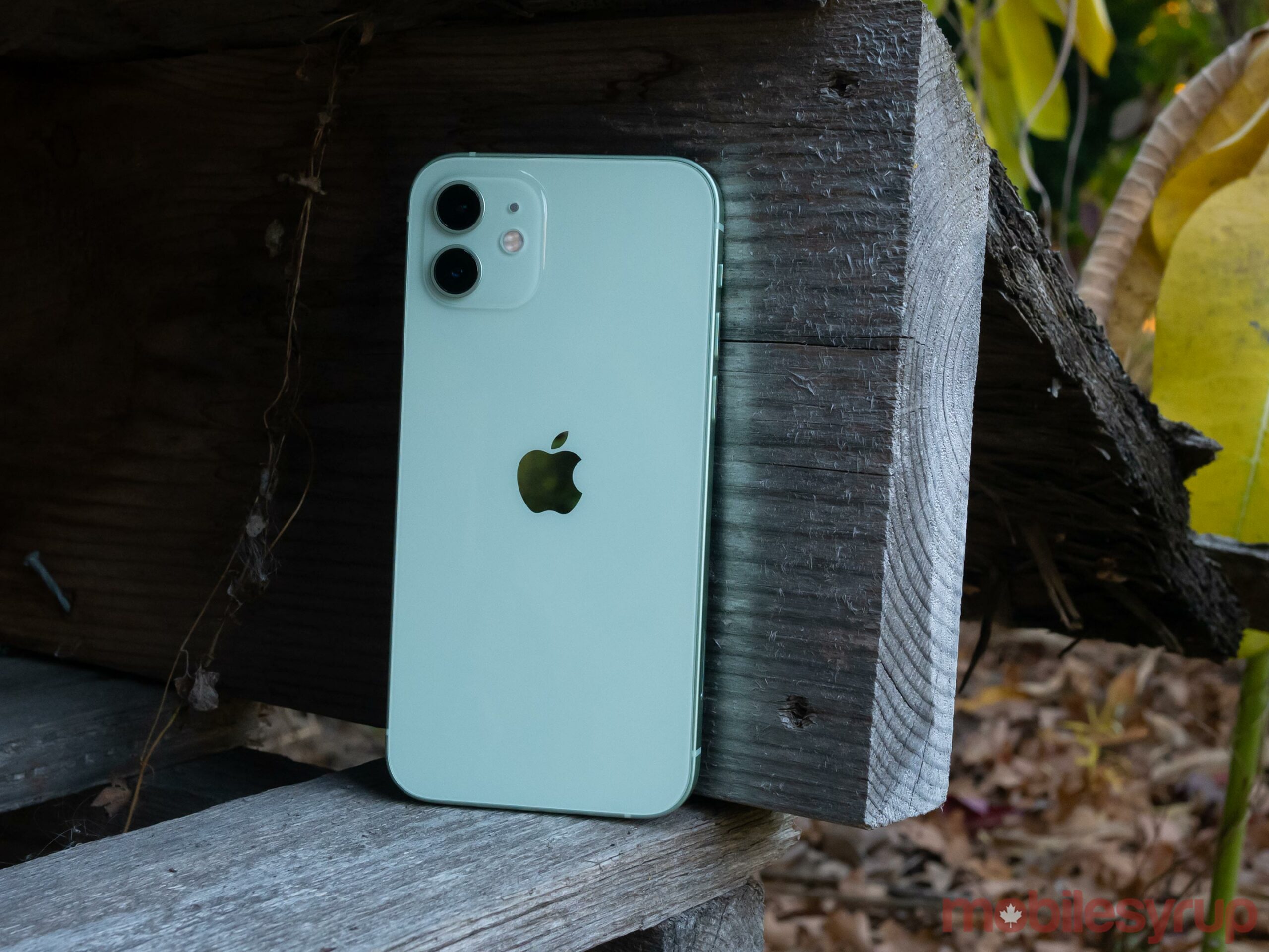
As expected, these upgrades also come at a price increase, with last year’s iPhone 11 costing $849 and the iPhone 12 bumping the price up to $1,129. A $280 difference is a pretty substantial price jump any way you look at it, though the inclusion of an OLED display helps soften that blow. On the other hand, the iPhone 12 mini costs a slightly more reasonable $979.
With all that in mind, it’s clear the iPhone 12/12 mini are likely the devices most Apple users should be interested in.
Update 09/11/2020: This review was updated with photos, image comparisons and information about the iPhone 12 mini. The review score was not changed.

Specs
iPhone 12
iPhone 12 mini
Display
6.1-inch, Super Retina XDR, OLED True Tone display, 2532 x 1170 pixels
5.4-inch, Super Retina XDR, OLED True Tone display, 2340 x 1080 pixels
Processor
A14 Bionic chip
A14 Bionic chip
RAM
4GB of RAM
4GB of RAM
Storage
64GB, 128GB, 256GB
64GB, 128GB, 256GB
Dimensions (in.)
146.7 x 71.5 x 7.4mm
131.5 x 64.2 x 7.4mm
Weight
162g
135g
Rear Facing Camera
12-megapixel (f/1.6, OIS, wide) + 12-megapixel (f/2.4, OIS, ultra-wide)
12-megapixel (f/1.6, OIS, wide) + 12-megapixel (f/2.4, OIS, ultra-wide)
Front Facing Camera
12-megapixel (f/2.2)
12-megapixel (f/2.2)
OS
iOS 14
iOS 14
Battery
(Up to 17 hours of video playback)
Up to 15 hours video playback
Network Connectivity
GSM/HSPA/LTE/5G
GSM/HSPA/LTE/5G
Sensors
TrueDepth Camera Sensor, Face ID, accelerometer, gyro, proximity, compass, barometer
Face ID, Three axis gyro, Accelerometer, Ambient light sensor, Barometer
SIM Type
Nano SIM, eSIM
Nano SIM, eSIM
Launch Date
October 13, 2020
October 13, 2020
Misc
Colours: Black, Green, Product Red, Blue, White |
Colours: Black, Green, Product Red, Blue, White |
Display
iPhone 12
6.1-inch, Super Retina XDR, OLED True Tone display, 2532 x 1170 pixels
iPhone 12 mini
5.4-inch, Super Retina XDR, OLED True Tone display, 2340 x 1080 pixels
Processor
iPhone 12
A14 Bionic chip
iPhone 12 mini
A14 Bionic chip
RAM
iPhone 12
4GB of RAM
iPhone 12 mini
4GB of RAM
Storage
iPhone 12
64GB, 128GB, 256GB
iPhone 12 mini
64GB, 128GB, 256GB
Dimensions (in.)
iPhone 12
146.7 x 71.5 x 7.4mm
iPhone 12 mini
131.5 x 64.2 x 7.4mm
Weight
iPhone 12
162g
iPhone 12 mini
135g
Rear Facing Camera
iPhone 12
12-megapixel (f/1.6, OIS, wide) + 12-megapixel (f/2.4, OIS, ultra-wide)
iPhone 12 mini
12-megapixel (f/1.6, OIS, wide) + 12-megapixel (f/2.4, OIS, ultra-wide)
Front Facing Camera
iPhone 12
12-megapixel (f/2.2)
iPhone 12 mini
12-megapixel (f/2.2)
OS
iPhone 12
iOS 14
iPhone 12 mini
iOS 14
Battery
iPhone 12
(Up to 17 hours of video playback)
iPhone 12 mini
Up to 15 hours video playback
Network Connectivity
iPhone 12
GSM/HSPA/LTE/5G
iPhone 12 mini
GSM/HSPA/LTE/5G
Sensors
iPhone 12
TrueDepth Camera Sensor, Face ID, accelerometer, gyro, proximity, compass, barometer
iPhone 12 mini
Face ID, Three axis gyro, Accelerometer, Ambient light sensor, Barometer
SIM Type
iPhone 12
Nano SIM, eSIM
iPhone 12 mini
Nano SIM, eSIM
Launch Date
iPhone 12
October 13, 2020
iPhone 12 mini
October 13, 2020
Misc
iPhone 12
Colours: Black, Green, Product Red, Blue, White |
iPhone 12 mini
Colours: Black, Green, Product Red, Blue, White |
Stainless steel vs. aluminum
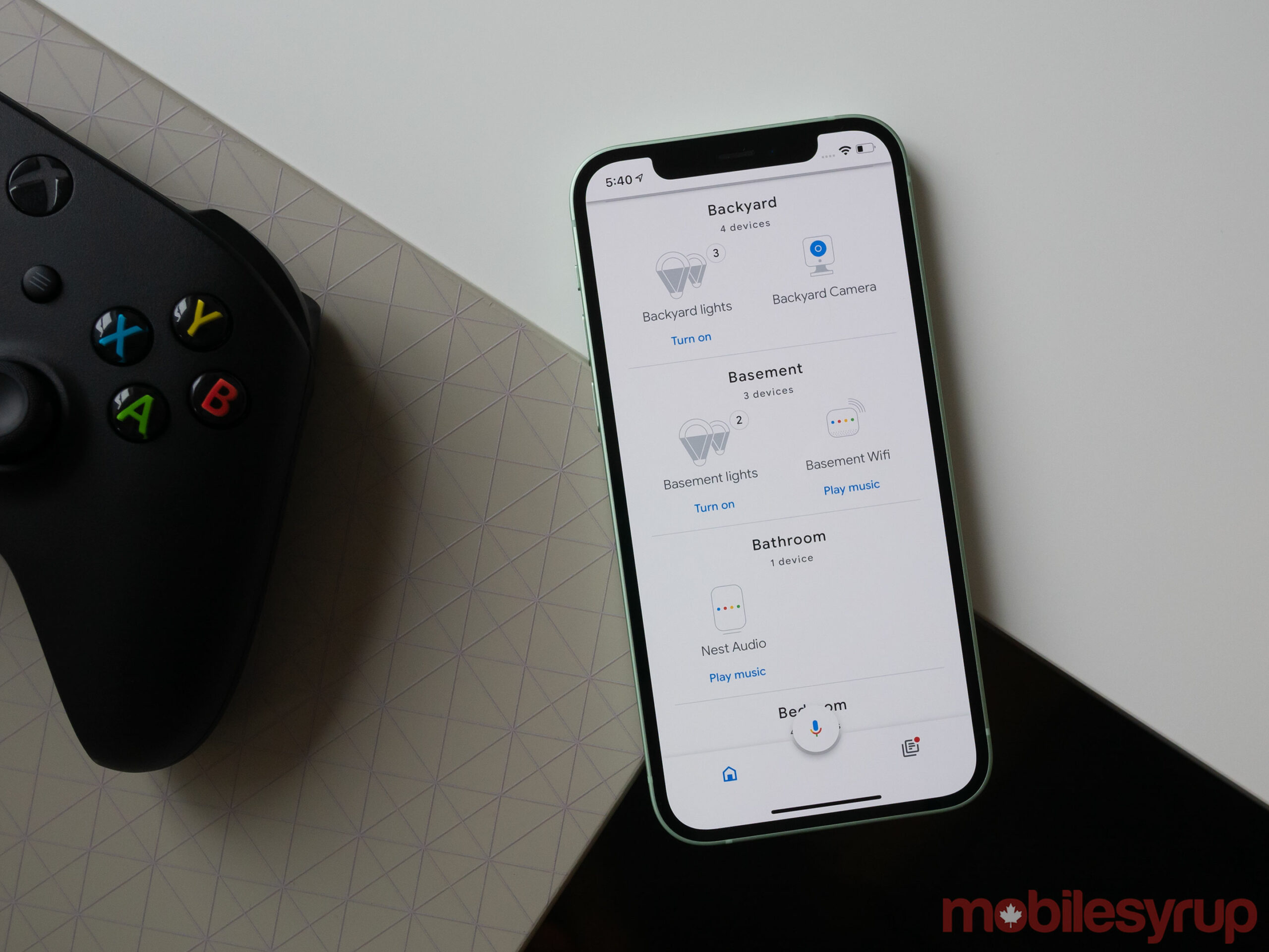
I’m shocked to be writing this, but I actually prefer the look of the iPhone 12 and iPhone 12 mini over the iPhone 12 Pro.
The smartphone features the same flat-edged iPad Air/iPhone 4-inspired design as the iPhone 12 Pro, but its matte aluminum edges get far less greasy than the stainless steel border featured in its higher-end counterpart. This gives the device a cleaner look when it isn’t inside a case and makes the smartphone feel better when you’re holding it in your hand.
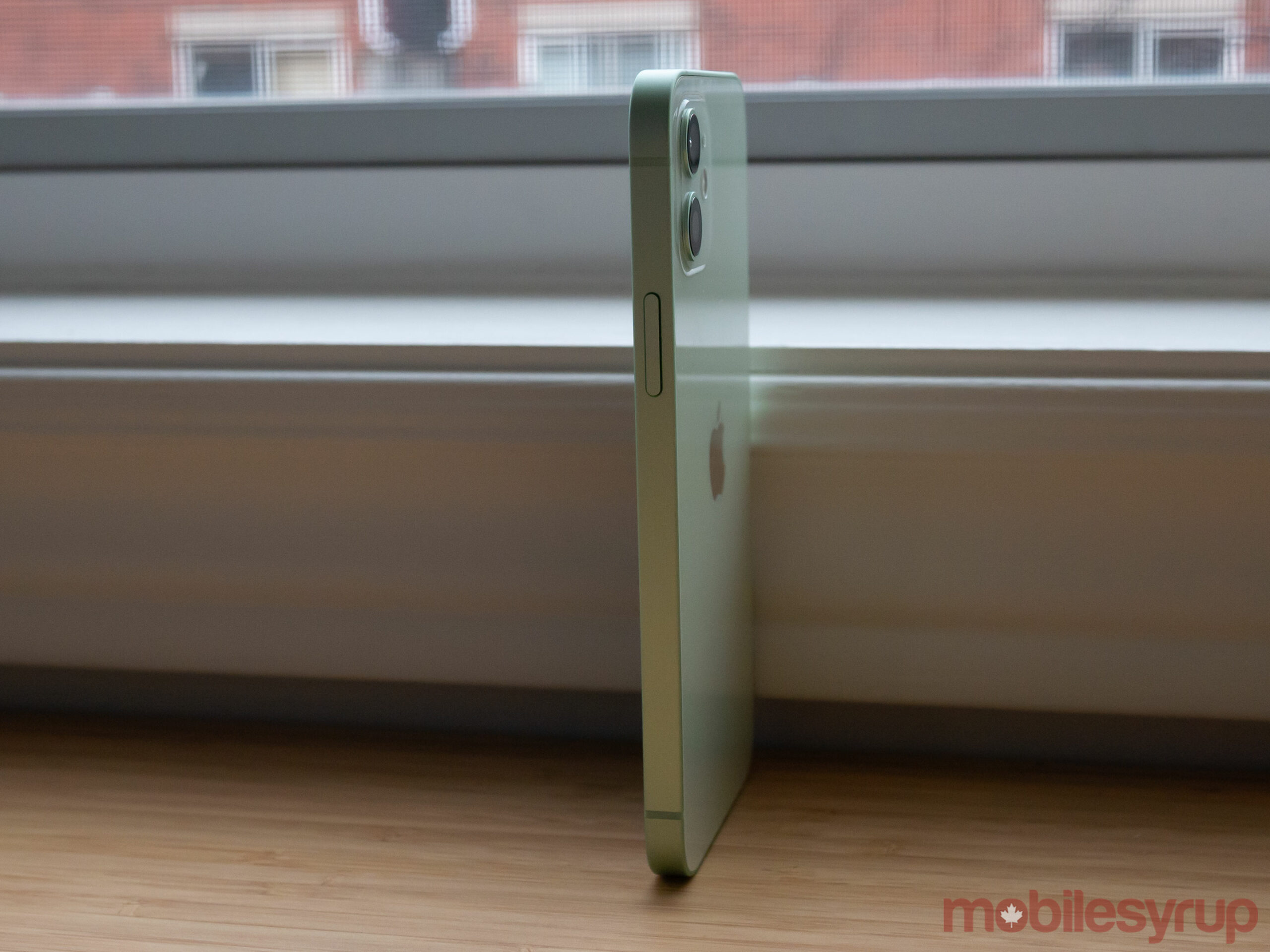
Like the iPhone 12 Pro, the iPhone 12/12 mini features a ‘Ceramic Shield’ front that Apple claims is more durable than previous iPhones. It’s impossible to verify this statement, but given how shockingly hardy the iPhone 11 was, I tend to believe Apple.
The smartphone itself is roughly 15 percent smaller than the iPhone 11, but it still features a 6.1-inch display thanks to its reduced bezels. This makes the device easier to hold in one hand than its predecessor. The 5.4-inch iPhone 12 mini feels ridiculously small, measuring in at even tinier than the iPhone SE (2020). Though I found the smartphone too small for my taste, it’s great to see Apple offer a modern device with this display size. There’s definitely an untapped market out there for smaller smartphones like the iPhone 12 mini.
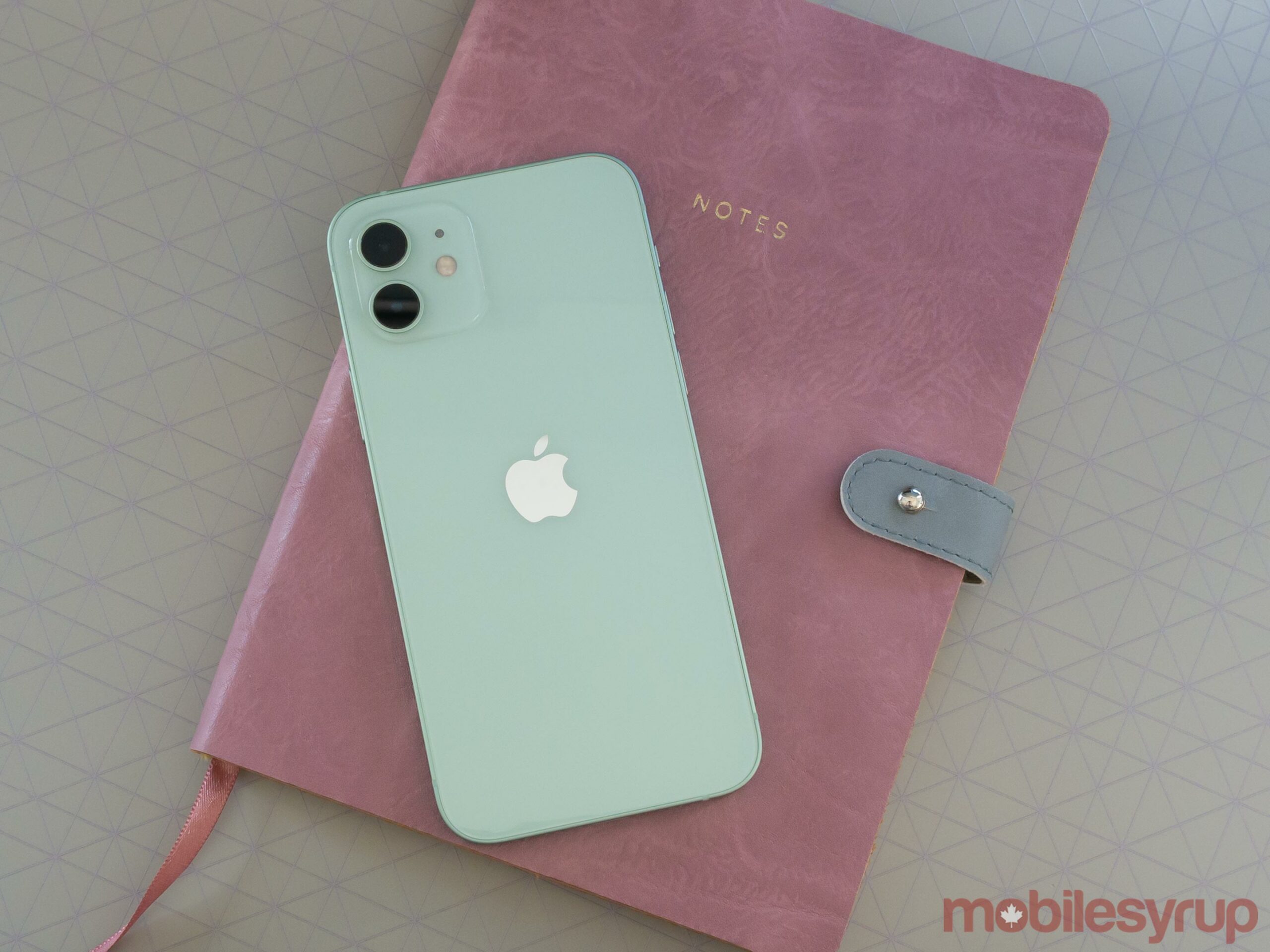
Colour-wise, I prefer the hues Apple offered last year with the iPhone 11, but the new green colour Apple sent me to review looks stunning. It’s light green and features an intensity not present in the iPhone 11’s colours. The black iPhone 12 mini, unfortunately, features a glossy, fingerprint and dust magnet rear that I’m not fond of. The iPhone 12 and iPhone 12 mini are available in the following colours: ‘Black,’ ‘White,’ ‘Green,’ ‘Blue’ and ‘Product Red,’
Each colour and the still-grease-resistant back glass — with black being the only exception — also match the iPhone 12’s overall hue, giving it a uniform look.

It’s worth noting the squared-off design might take some long-time iPhone users a little getting used to and, for a select few, could even feel like a step backwards.
While I initially counted myself in this camp, the design quickly grew on me. It looks and feels great and is a solid step forward for Apple’s iPhone line in terms of aesthetic.
Say hello to OLED
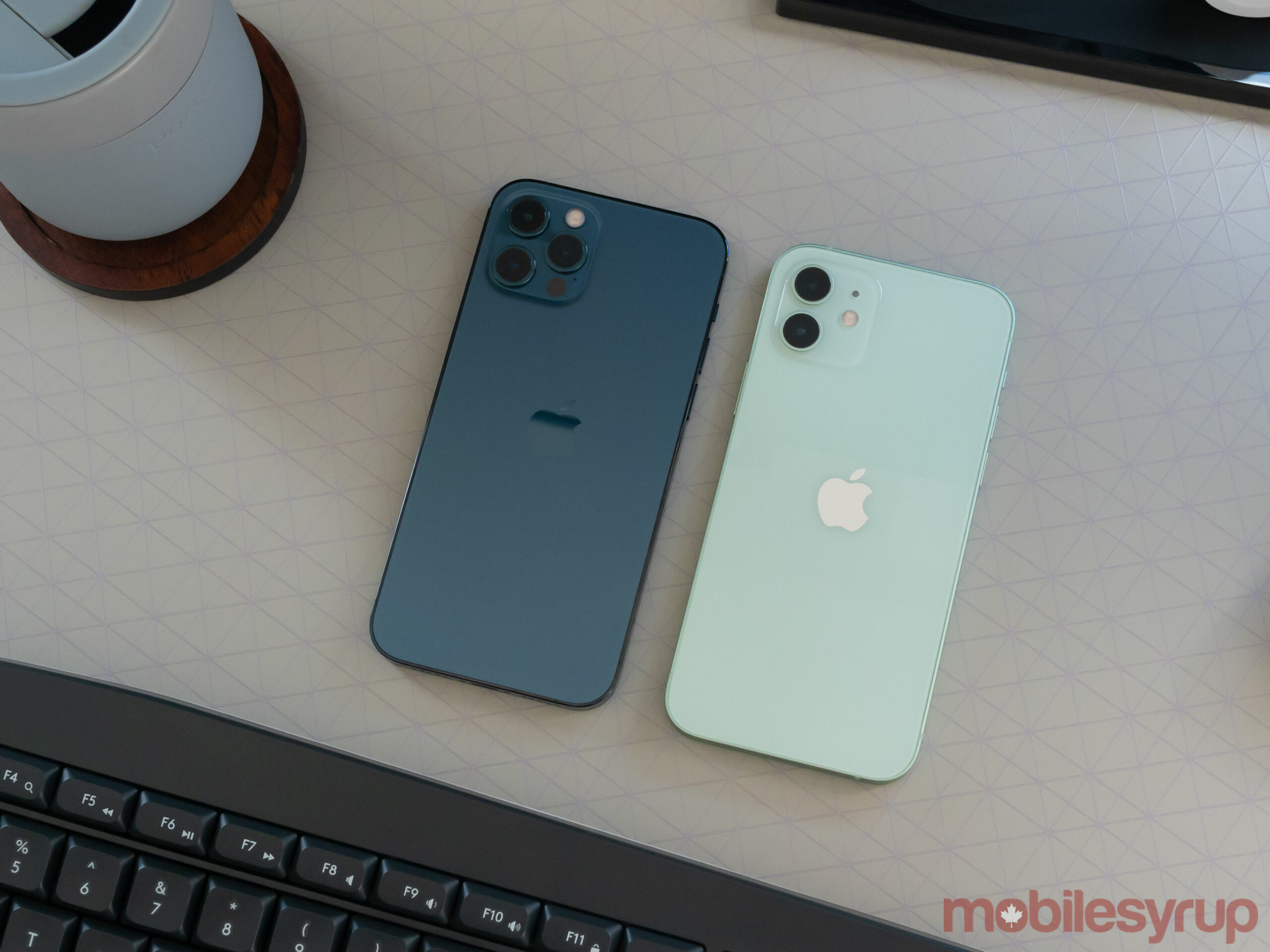
What’s most interesting about this year’s iPhone lineup is the iPhone 12/12 mini and iPhone 12 Pro/iPhone 12 Pro Max are nearly identical in several ways.
For example, the iPhone 12 features a 6.1-inch Super Retina XDR display that comes in at 2,532 x 1,170 pixels and 460ppi, just like the iPhone 12 Pro. The screen also supports ‘True Tone,’ HDR capabilities, features a P3 wide colour gamut, and includes the same 2,000,000:1 contrast ratio as the more expensive iPhone 12 Pro.

The only difference is the iPhone 12 Pro and iPhone 12 Pro Max’s standard max brightness measures in at 800 nits compared to the iPhone 12’s 625 nits. This change isn’t noticeable at all, and in general, the iPhone 12 and iPhone 12 mini’s display looks stunning and a significant step above last year’s solid but rapidly ageing Liquid Retina LCD screen that came in at a 1,792 x 828 pixel resolution. Video content with apps like Netflix and YouTube, as well as games and even just browsing the internet, all look great.
“My experience with the iPhone 12 and iPhone 12 mini has been extremely smooth over the last few days and I haven’t encountered a single instance of lag”
Like last year, the iPhone 12 features the same chip as its more expensive counterpart, the new A14 Bionic processor. Though I don’t put much stock into benchmarks because they don’t speak to how a phone operates in the real world, the iPhone comes in at 1,596 for its single-core score and 4,025 for its multi-core score with Geekbench, which is a substantial increase over the A13-equipped iPhone 11 coming in at 1,326 and the 3,397. My experience with the iPhone 12 and iPhone 12 mini has been extremely smooth over the last few days and I haven’t encountered a single instance of lag.
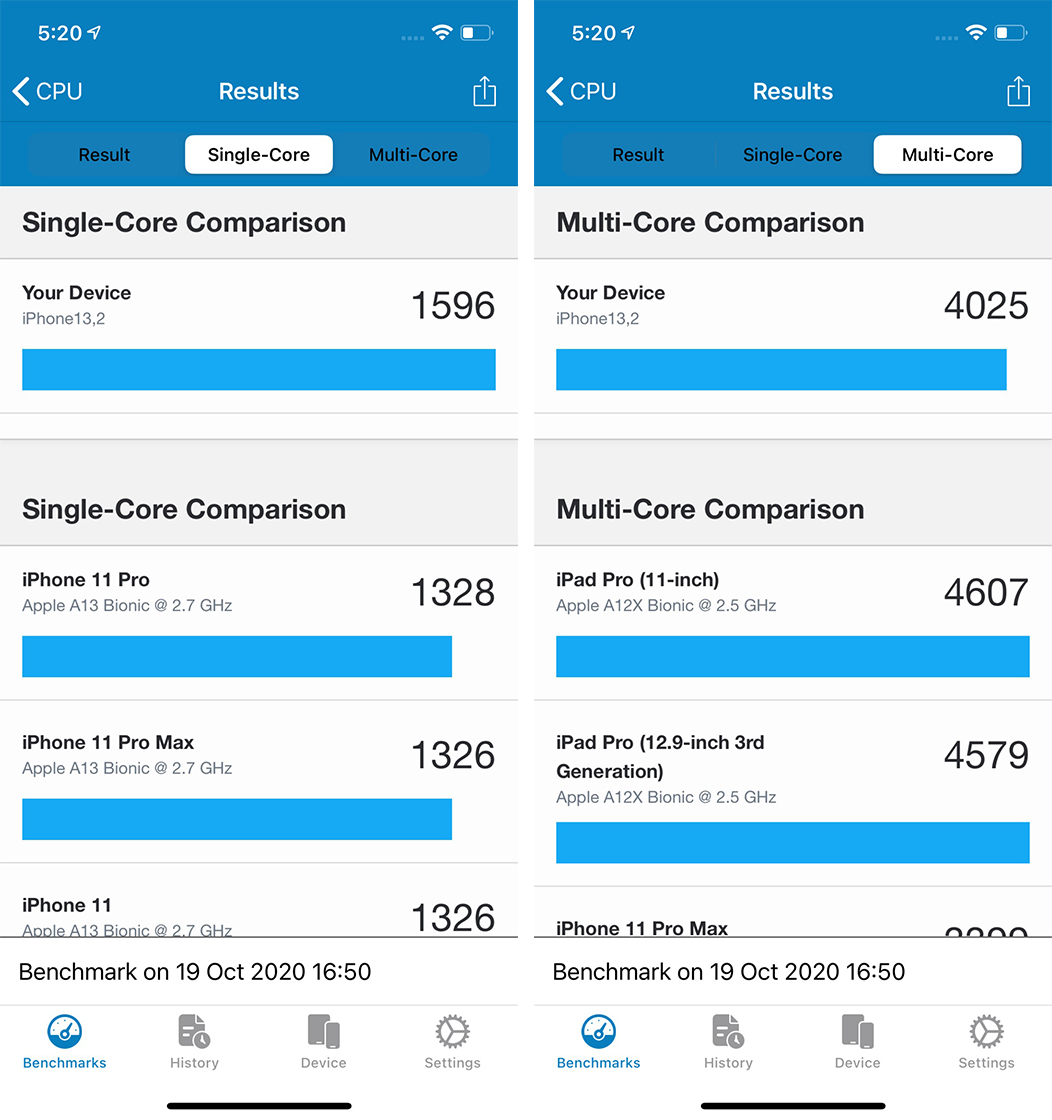
The other differences worth noting about the iPhone 12 and iPhone 12 mini are that they weigh 162g and 133g, respectively, compared to the iPhone 12 Pro and iPhone 12 Pro Max coming in at 187g and 226g. While the iPhone 12 feels light, sometimes I forgot that the iPhone 12 mini was even in my pocket. Just like last year, storage options include 64GB, 128GB and 256GB. It would have been great to see Apple bump the starting storage up to at least 128GB given the company’s smartphones lag behind nearly every Andriod manufacturer in this department.
Regarding battery life, I found that the iPhone 12 and iPhone 12 mini come in at roughly a day with moderate use, which is similar to my experience with the iPhone 12 Pro.
Camera improvements
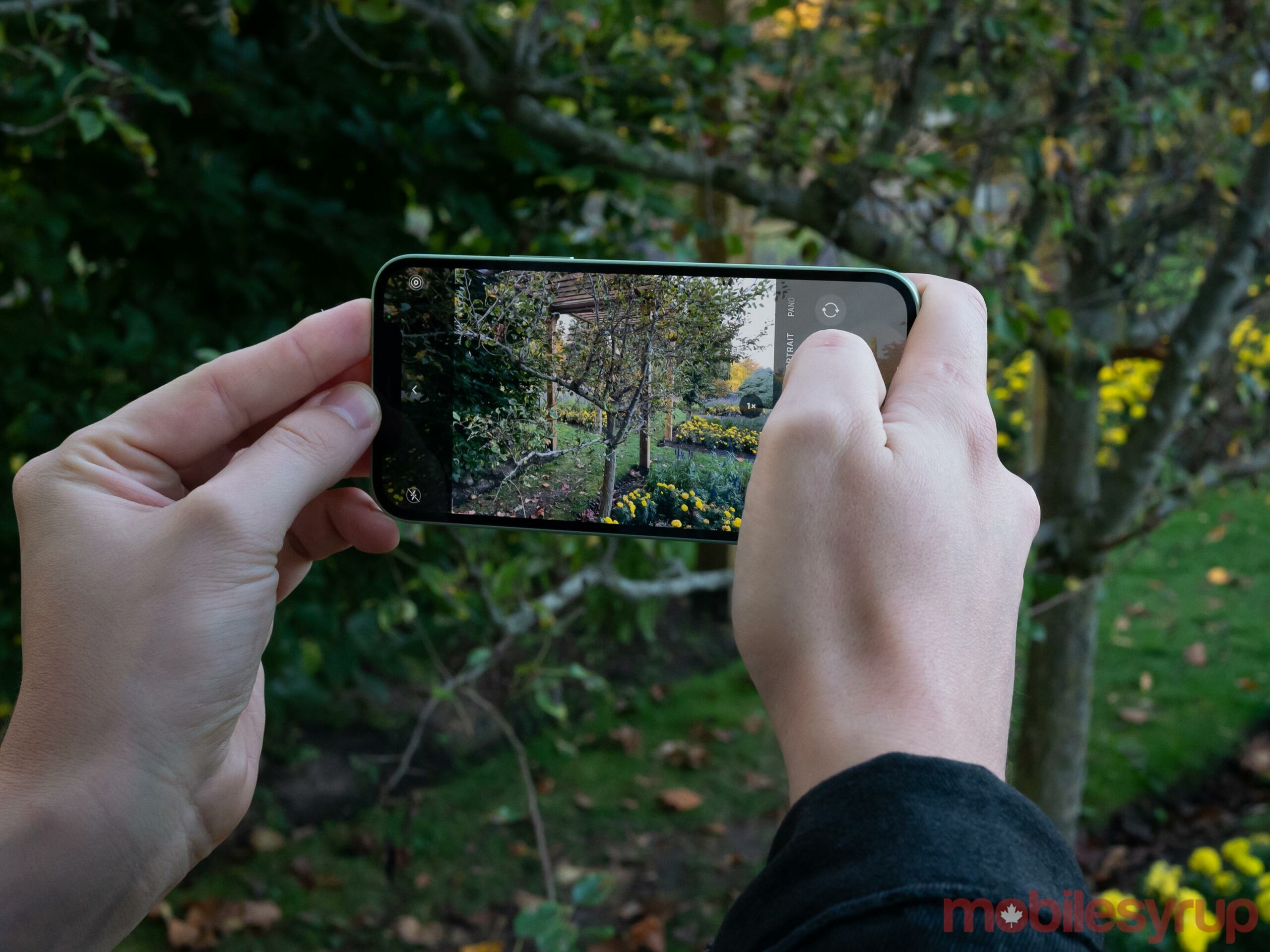
Similar to the iPhone 12 Pro, the most significant changes to the iPhone 12 and iPhone 12 mini relate to the smartphone’s camera performance.
First off, the array is very similar to the iPhone 12 Pro and iPhone 12 Pro Max’s, including a wide f/1.6 lens and an ultrawide f/2.4 aperture. However, the iPhone 12 and iPhone 12 mini don’t feature the iPhone 12 Pro series’ telephoto lens, which means it isn’t capable of 2x optical zoom. However, both smartphones include otherwise nearly identical camera arrays.
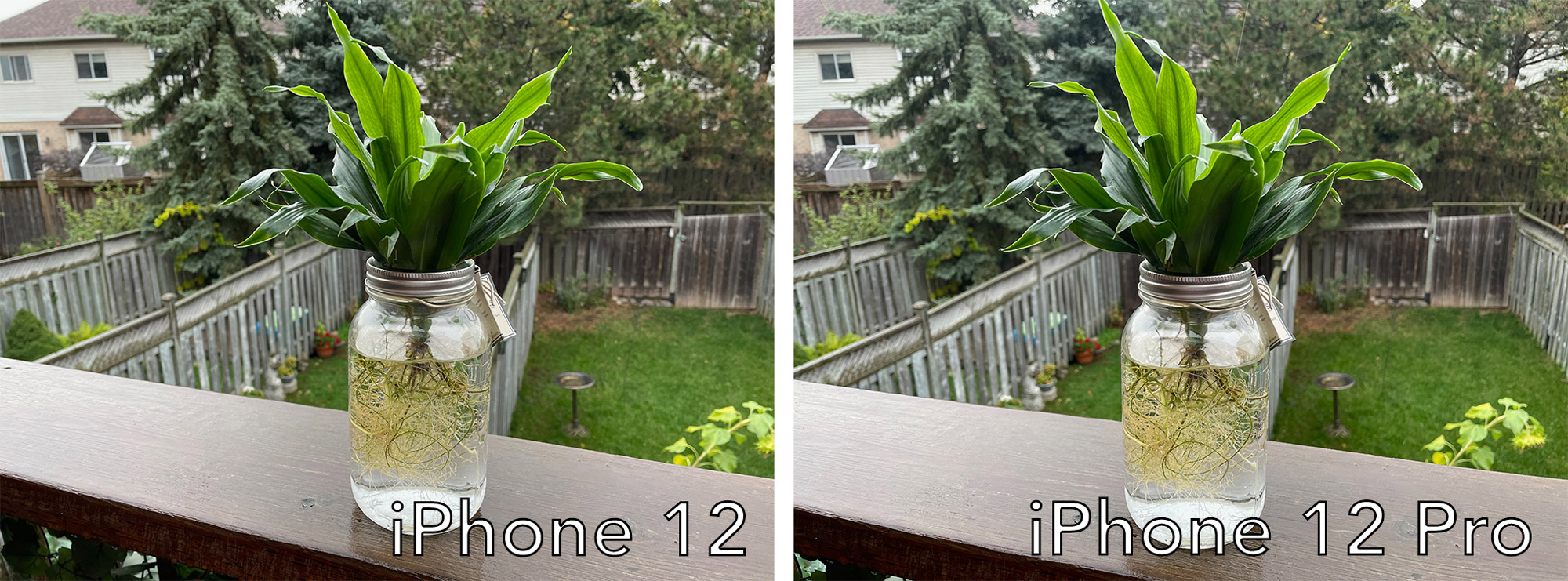
The iPhone 12’s camera is on the left and the iPhone 12 Pro’s is on the right. While the images are nearly identical, the iPhone 12 Pro features slightly more contrast.
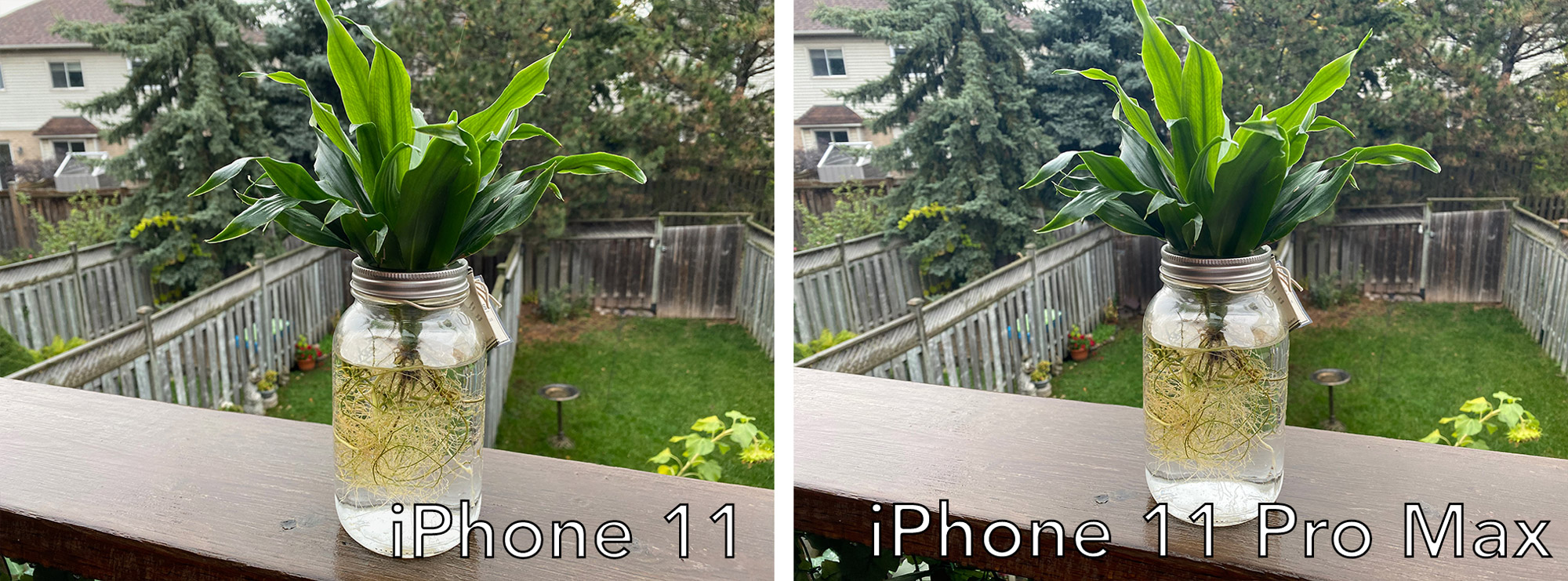
The iPhone 11’s wide shooter is on the left side, and the iPhone 11 Pro Max’s wide camera is on the right. The images above shot with the iPhone 12 and iPhone 12 Pro are slight improvements over the iPhone 11 and iPhone 11 Pro Max.
I’d argue a wide-angle lens is likely more useful for taking group shots and capturing landscapes, but it really depends on the type of photography you do with your smartphone. For example, I value 2x/2.5x zoom over wide-angle photography because I often find myself shooting landscapes and not large groups of people.
While the ultrawide lens measures in at the same f/2.4 aperture, the wide lens comes in at f/1.6 and now has seven-elements, which allows more light into the sensor, resulting in overall brighter, less noisy images, especially when under low-light.
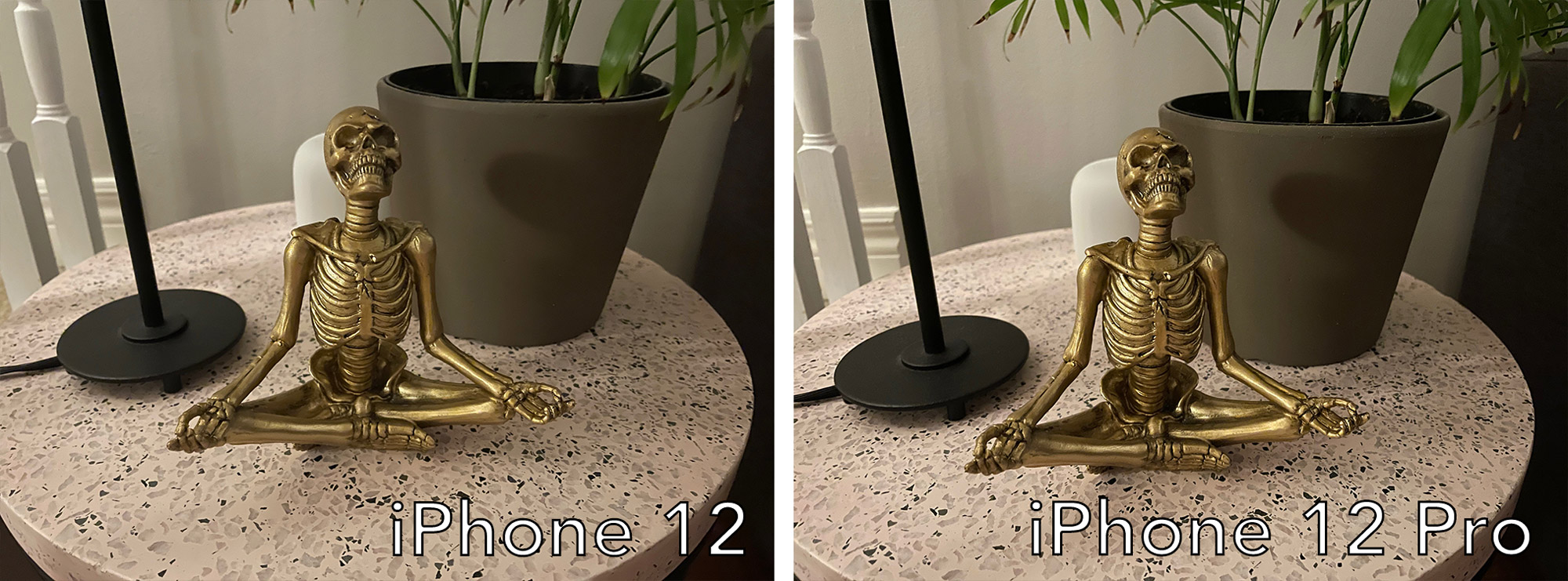
The iPhone 12 wide camera is on the left side, and the iPhone 12 Pro’s wide camera is right. Though the pictures are very similar, the photo shot with the iPhone 12 Pro features slightly more contrast and overall better tones.
It’s also worth noting the iPhone 12 and iPhone 12 mini don’t support Apple’s new ProRaw image format that’s launching later this year because the phones lack the iPhone 12 Pro’s LiDAR sensor.
While not a significant hit to camera quality, this means the iPhone 12 doesn’t benefit from the same quicker focusing and improved low-light performance as the iPhone 12 Pro. However, it does still feature Apple’s new Smart HDR 3 technology coupled with Deep Fusion, night mode and, of course, Portrait Mode.
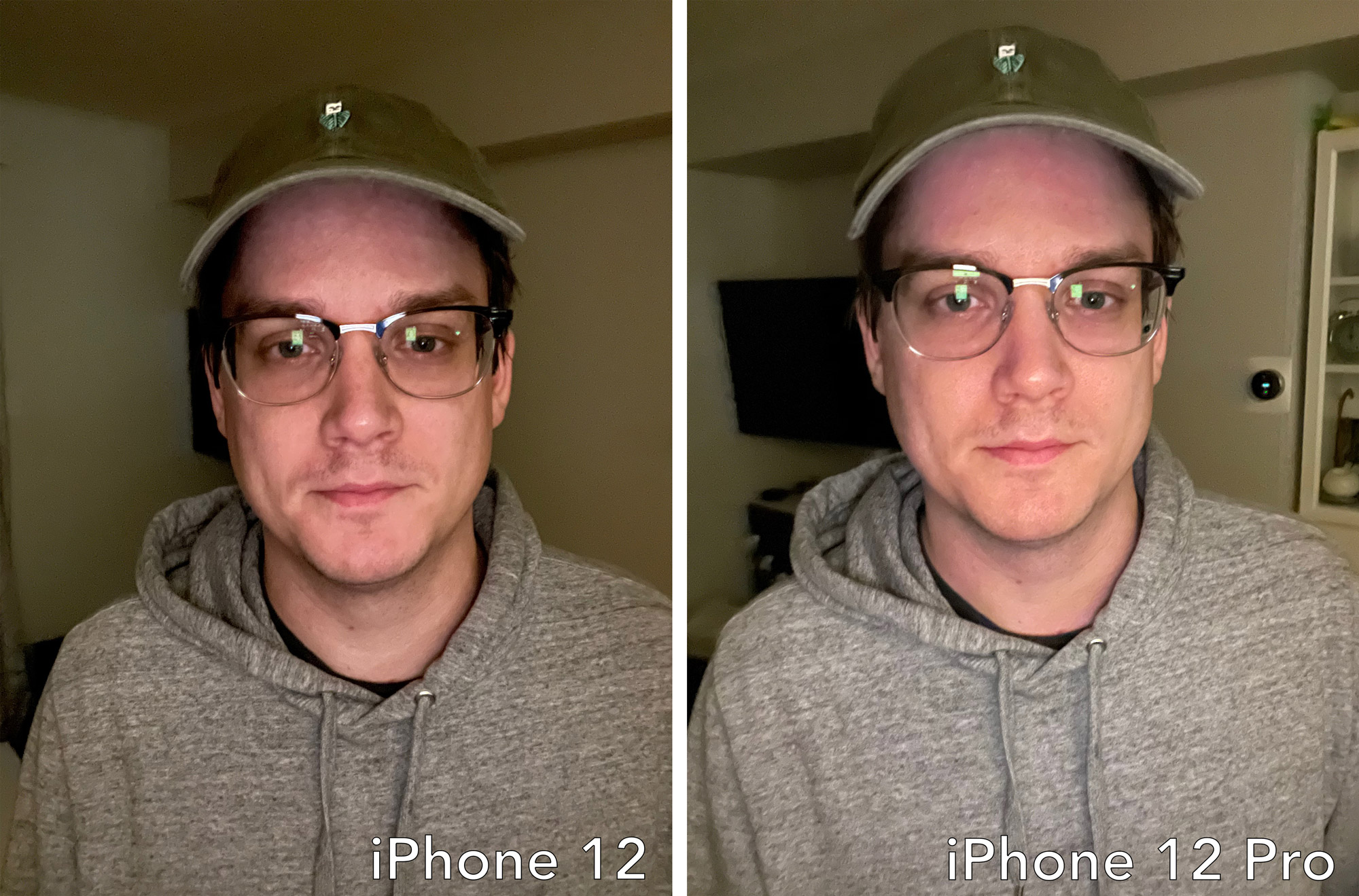
The iPhone 12’s selfie shooter is on the left with night mode turned on, and the iPhone 12 Pro’s selfie shooter is on the right with night mode turned on. Night mode selfies are generally pretty blurry and give skin a very plastic tone.
The iPhone 12 and iPhone 12 mini feature the same new night mode selfie shots with the smartphone’s front-facing 12-megapixel camera, but they’re a little darker and pretty noisy. I don’t find this new feature very useful and feel it gives skin a weird, over-detailed and almost plastic tone. The device’s ultrawide camera also now works in night mode and produces images nearly identical to the iPhone 12 Pro’s that feature slightly more noise and less contrast.
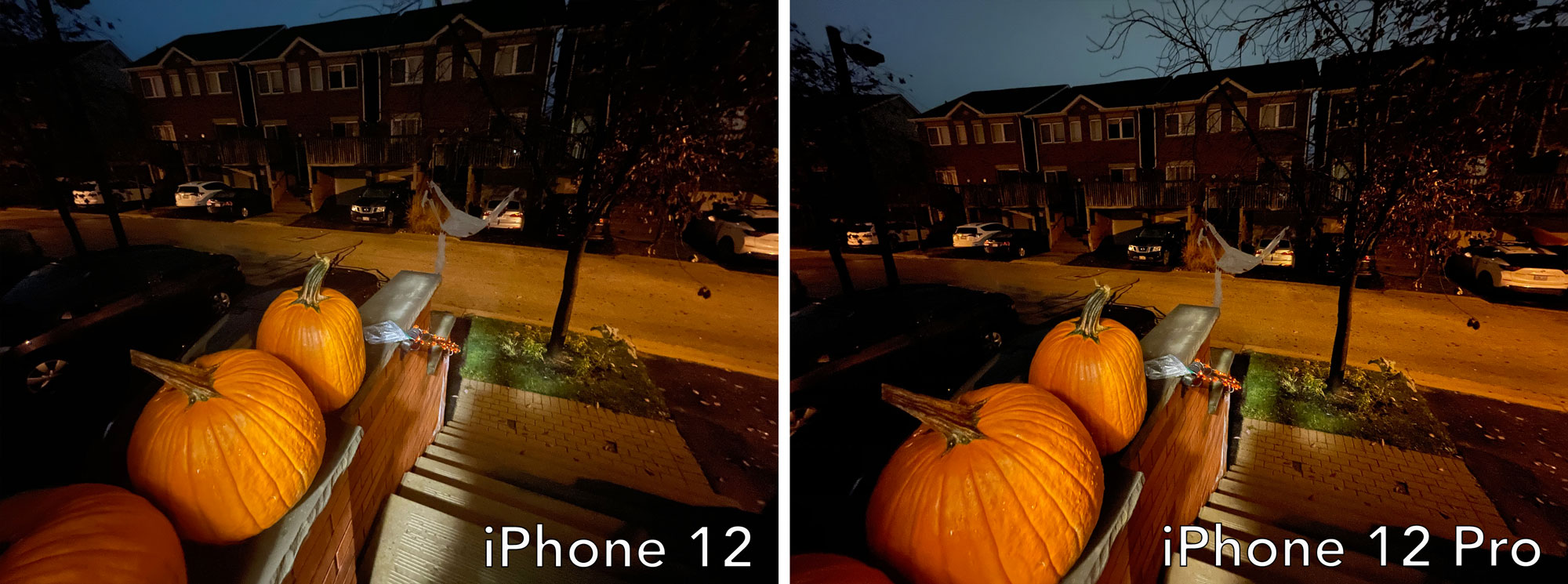
The iPhone 12 ultrawide image is on the left, and the iPhone 12 ultrawide shot is on the right. Though the images are very similar, the iPhone 12 photo features slightly more vibrant colours and more contrast.
Photos generally look better than those shot with the iPhone 11. However, they’re slightly noisier, a little less sharp and don’t feature as much contrast as what the iPhone 12 Pro and iPhone 12 Pro Max can shoot. Overall, the difference is surprisingly marginal.
Further, instead of dual optical image stabilization or sensor shift technology, the iPhone 12 and iPhone 12 mini feature optical image stabilization. In my tests, I didn’t find that this really made much of a difference when snapping photos, even when using the smartphone’s night mode.
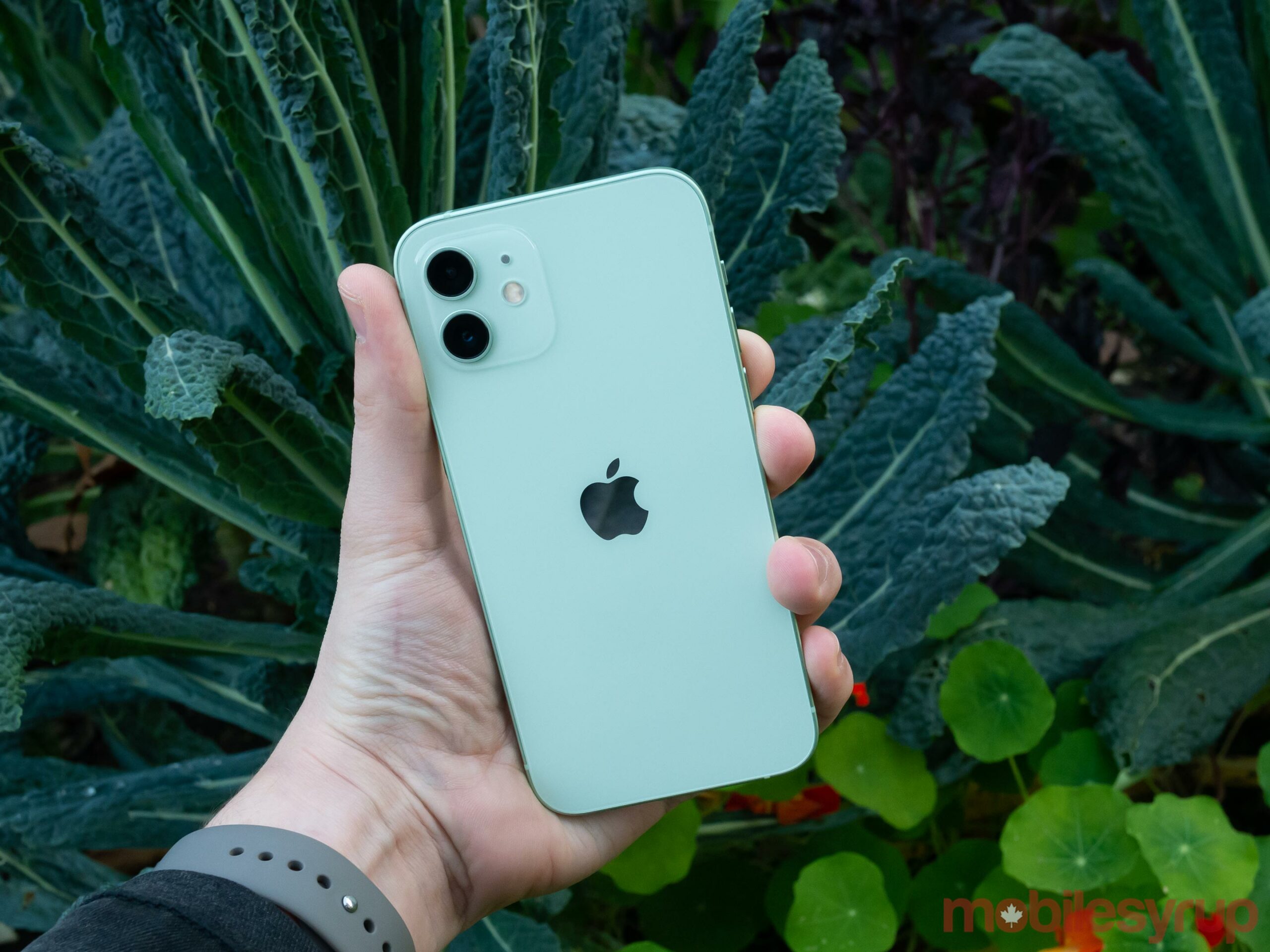
Finally, the iPhone 12 also features 10-bit Dolby Vision HDR video recording — a first for any smartphone — that can only be viewed on supported televisions and monitors.
That said, even YouTube doesn’t support the format. The iPhone 12 only includes HDR 4K Dolby Vision video at 30fps compared to the iPhone 12 Pro’s 60fps.
Everything else
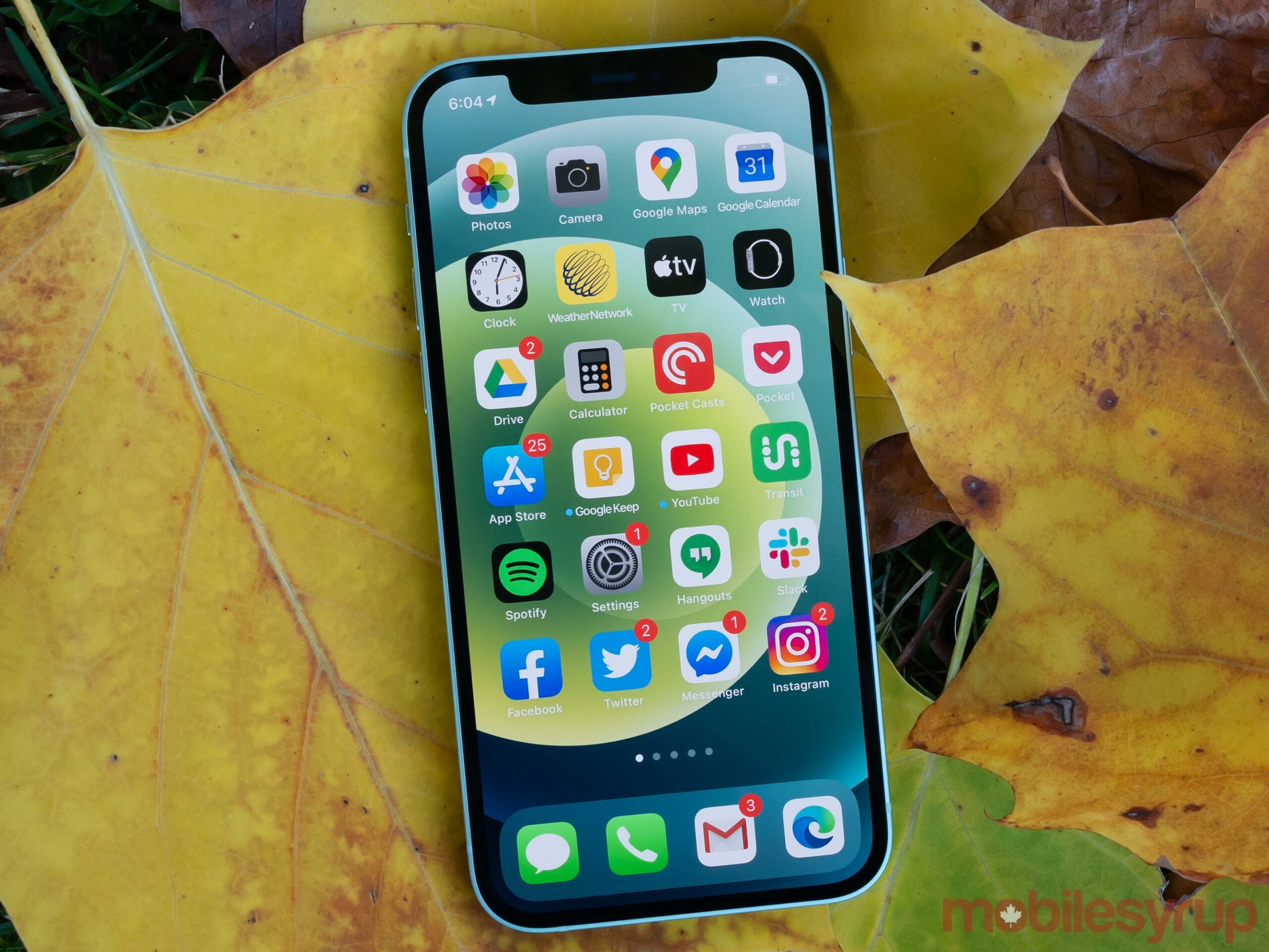
Unlike in previous years, the iPhone 12/iPhone 12 mini and the iPhone 12 Pro/iPhone 12 Pro Max offer a very similar smartphone experience, and because of this, there are several aspects of the device this review doesn’t touch on.
If you’re interested in learning more about what it’s like to use an iPhone 12 with 5G in Canada and Apple’s MagSafe accessories, follow this link to my iPhone 12 Pro and iPhone 12 Pro Max review.
Other things worth noting are that the iPhone 12 features Face ID that seems just as reliable as last year, with authentication working roughly 95 percent of the time.

Most people won't need an iPhone 12 Pro
The main takeaway from my time with iPhone 12 and iPhone 12 mini is that across the board, the average iPhone user likely won't need the features that the iPhone 12 Pro offers, especially now that the smartphones include great-looking and vibrant OLED displays. On the other hand, if you're a smartphone photography enthusiast, the incremental improvements the iPhone 12 Pro and iPhone 12 Pro Max offer could be worth the upgrade.
Overall, though, the iPhone 12 and iPhone 12 mini offer photography and performance capabilities nearly identical to the iPhone 12 Pro series'. That said, the devices' low-light performance isn't quite as solid because the iPhone 12 and iPhone 12 mini don't feature a LiDAR sensor.
With all this in mind, the iPhone 12 is one of the most solid smartphone packages the tech giant has released in years. The iPhone 12 starts at $1,129 for the 64GB version. The 128GB version costs $1,199 and the 256GB iteration costs $1,339. The iPhone 12 mini starts at $979 for the 64GB iteration. The 128GB version costs $1,049 and the 256GB costs $1,189.
For my iPhone 12 Pro and iPhone 12 Pro Max review, follow this link.
"The main takeaway from my time with iPhone 12 and iPhone 12 mini is that across the board, the average iPhone user likely won't need the features that the iPhone 12 Pro offer"
MobileSyrup may earn a commission from purchases made via our links, which helps fund the journalism we provide free on our website. These links do not influence our editorial content. Support us here.





